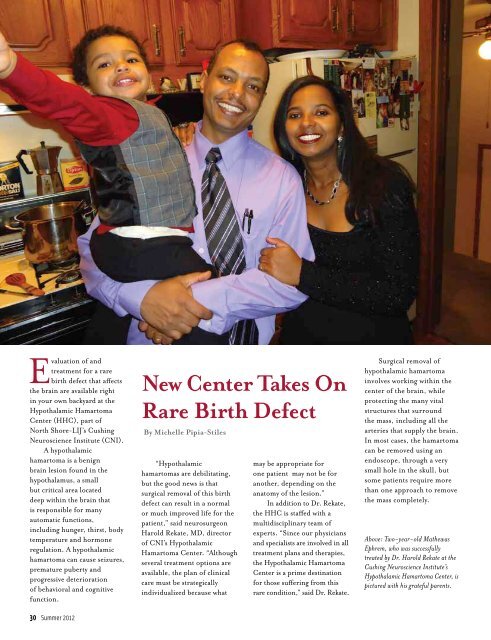Support for Soldiers and Veterans You Gotta Have Heart The Joy of ...
Support for Soldiers and Veterans You Gotta Have Heart The Joy of ...
Support for Soldiers and Veterans You Gotta Have Heart The Joy of ...
You also want an ePaper? Increase the reach of your titles
YUMPU automatically turns print PDFs into web optimized ePapers that Google loves.
Evaluation <strong>of</strong> <strong>and</strong><br />
treatment <strong>for</strong> a rare<br />
birth defect that affects<br />
the brain are available right<br />
in your own backyard at the<br />
Hypothalamic Hamartoma<br />
Center (HHC), part <strong>of</strong><br />
North Shore-LIJ’s Cushing<br />
Neuroscience Institute (CNI).<br />
A hypothalamic<br />
hamartoma is a benign<br />
brain lesion found in the<br />
hypothalamus, a small<br />
but critical area located<br />
deep within the brain that<br />
is responsible <strong>for</strong> many<br />
automatic functions,<br />
including hunger, thirst, body<br />
temperature <strong>and</strong> hormone<br />
regulation. A hypothalamic<br />
hamartoma can cause seizures,<br />
premature puberty <strong>and</strong><br />
progressive deterioration<br />
<strong>of</strong> behavioral <strong>and</strong> cognitive<br />
function.<br />
30 Summer 2012<br />
New Center Takes On<br />
Rare Birth Defect<br />
By Michelle Pipia-Stiles<br />
“Hypothalamic<br />
hamartomas are debilitating,<br />
but the good news is that<br />
surgical removal <strong>of</strong> this birth<br />
defect can result in a normal<br />
or much improved life <strong>for</strong> the<br />
patient,” said neurosurgeon<br />
Harold Rekate, MD, director<br />
<strong>of</strong> CNI’s Hypothalamic<br />
Hamartoma Center. “Although<br />
several treatment options are<br />
available, the plan <strong>of</strong> clinical<br />
care must be strategically<br />
individualized because what<br />
may be appropriate <strong>for</strong><br />
one patient may not be <strong>for</strong><br />
another, depending on the<br />
anatomy <strong>of</strong> the lesion.”<br />
In addition to Dr. Rekate,<br />
the HHC is staffed with a<br />
multidisciplinary team <strong>of</strong><br />
experts. “Since our physicians<br />
<strong>and</strong> specialists are involved in all<br />
treatment plans <strong>and</strong> therapies,<br />
the Hypothalamic Hamartoma<br />
Center is a prime destination<br />
<strong>for</strong> those suffering from this<br />
rare condition,” said Dr. Rekate.<br />
Surgical removal <strong>of</strong><br />
hypothalamic hamartoma<br />
involves working within the<br />
center <strong>of</strong> the brain, while<br />
protecting the many vital<br />
structures that surround<br />
the mass, including all the<br />
arteries that supply the brain.<br />
In most cases, the hamartoma<br />
can be removed using an<br />
endoscope, through a very<br />
small hole in the skull, but<br />
some patients require more<br />
than one approach to remove<br />
the mass completely.<br />
Above: Two-year-old Mathewas<br />
Ephrem, who was successfully<br />
treated by Dr. Harold Rekate at the<br />
Cushing Neuroscience Institute’s<br />
Hypothalamic Hamartoma Center, is<br />
pictured with his grateful parents.




